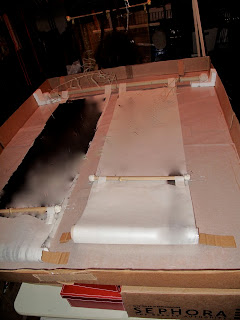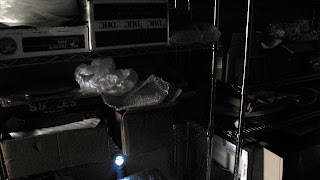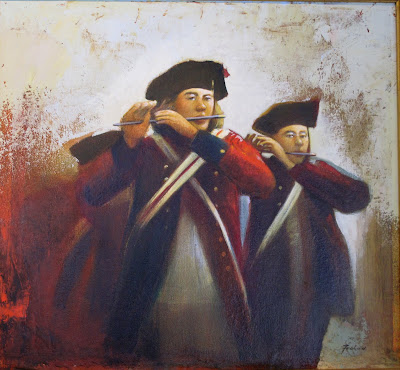 |
| above: repaired area |
Creating this work was personally significant for me and I believe it is also a strong work of art. Below is a photo of the entire mixed media piece as it was exhibited in my show at the Rider University Art Gallery this October. There is also companion floor sculpture, "Top Soil", which has not been shown yet. Every work of art is a journey of creation, but this one took a subject matter path I'd not been on before.
 |
| "BIOGRAPHY OF A MOTH", ©Joy Kreves '10, ~60"X40" |
"BIOGRAPHY OF A MOTH" began as a piece to go directly on the wall, with the working title of "ELAINE'S GARDEN". Elaine is a friend who has a magical garden surrounding her house. As I worked on the piece with it's quiet yarns and glazes, a photo of my mother (1922-2000) as an 18 yr. old that I have hanging in my studio began to draw towards the art. By this I mean that there was an attraction between the photo and the artwork. Anyone who has hung an art exhibition knows that certain pieces create a synergy when hung in proximity to each other, and other pieces seem to not get along well with each other at all.
 |
| Detail, "Biography of a Moth", ©Joy Kreves '10 |
Perhaps it was simply the sympathetic browns in the photo and the wood and yarns, perhaps it was also because my mother crocheted and was an avid gardener of both vegetables and flowers or the way her jacket is flapping open like a moth wing. In any case, she seemed to want to be part of the piece. So with apologies to Elaine and her wondrous garden, I went with the subject matter shift and let the piece be about my mother. Once that decision was made, her presence infused my work to the extent that on a few occasions I had to work with tear-filled eyes. I am not usually an extremely emotional artist, at least I normally do not work in any particularly strong emotional state, so this was a very strange experience for me. A sense of sadness persisted through the duration of the creation of this piece. It took me by complete surprise, because although we were very close and even best friends in my adult years, I thought I had pretty much finished grieving for her long ago. Art has a way of digging very, very deep though, and here I was re-experiencing my loss.
 |
| "Elaine's Garden" (beginnings of "Bio of a Moth"),©Joy Kreves'10 |
The next really odd thing about my journey through this artwork was the major "DUH" moment that it brought to me. Art is a mirror to both society and the artist. Sometimes we need to rub our eyes and take a better look. Once I planted a copy of my mother's photo and the moth imagery in the piece it acquired the title, "Biography of a Moth", yet it never even occurred to me, until I was putting up the show, that "Moth" is the beginning of "Mother". I had been thinking all about how my mother had tread so lightly on the earth like a butterfly, but because she was so UNflashy and UNdemanding of attention, a moth seemed the better symbol for her. She tended to her plants with quiet though passionate care until the very end of her life.
 |
| moth holes detail, "Biography of a Moth", ©Joy Kreves '10 |
Perhaps the "moth holes" I put in the river photo section of the piece are really symbols of all the little holes her death left in my world. She left not one big, gaping hole, but many small ones that have significantly riddled life as I experience it, like the holes left when pulling stray plants from a garden. Creating this work was a huge gift for me in renewed appreciation for the ways in which a parent's life is carried on and on in their children. Carrying on the word "moth" one gets to "mother". This work is, indeed, "Biography of a MothER".












































